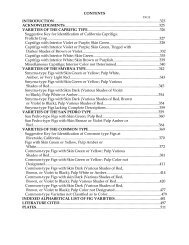Create successful ePaper yourself
Turn your PDF publications into a flip-book with our unique Google optimized e-Paper software.
20 A. Salhi-Hannach et al. Hereditas 143 (2006)<br />
b<br />
a<br />
c<br />
d<br />
0.1<br />
05*<br />
11*<br />
07*<br />
01*<br />
15*<br />
06*<br />
10*<br />
02*<br />
03*<br />
04*<br />
12*<br />
13*<br />
08*<br />
09*<br />
14*<br />
16*<br />
17*<br />
30***<br />
29**<br />
25**<br />
20**<br />
24**<br />
26**<br />
35***<br />
27**<br />
28**<br />
22**<br />
33***<br />
31***<br />
32***<br />
23**<br />
34***<br />
19**<br />
18**<br />
21**<br />
Fig. 3. Dendrogram of 35 Tunisian fig ecotypes constructed by UPGMA<br />
and based on RAPD banding patterns (§ table I for ecotypes’ labels).<br />
([10*] and [11*]). The opposite situation is observed in<br />
the case of Soltani [02*] and Khahli [03*] that are<br />
nearly similar. The hypothesis of synonymy could be<br />
forwarded to explain these particularities.<br />
On the other hand, the dendrogram illustrates<br />
ecotype clustering made independently from the sex<br />
of the trees since the male accessions labelled [16*],<br />
[17*] and [30***] did not significantly diverge from the<br />
female ones. This result suggests the presence of a<br />
narrow genetic diversity in the accessions studied.<br />
DISCUSSION AND CONCLUSION<br />
Fingerprinting of the Tunisian fig was carried out<br />
using RAPD in order to obtain molecular data of<br />
the national gene pool. The present study shows the<br />
reliability of RAPD analysis to detect DNA polymorphisms<br />
in this crop. In fact, the tested primers are<br />
characterised by relatively high collective Rp rate of<br />
21.771. Similar Rp values have been reported in<br />
Tunisian figs using either RAPD or ISSR methods<br />
(SALHI-HANNACHI et al. 2004b). The primers generated<br />
44 polymorphic out of 63 bands with a mean of<br />
7.33. This is significantly higher than reported for fig<br />
varieties originating from the French CBNM of<br />
Porquerolles island (KHADARI et al. 1995). Using<br />
nine universal primers tested in 30 fig varieties, we<br />
registered a mean of 2.2 markers per primer. Thus, we<br />
may assume that the Tunisian fig germplasm is<br />
characterised by a relatively high genetic diversity at<br />
the DNA level. This assumption is strongly supported<br />
with regard to the scored genetic distances among the<br />
ecotypes studied (0.00 to 0.78).H<br />
The UPGMA cluster analysis divided the genotypes<br />
studied into two main groups that are consistently in<br />
agreement, in major part, with their geographic origin.














![Fig Trees in North Carolina [Archive] - IDigMyGarden ... - Figs 4 Fun](https://img.yumpu.com/26905320/1/190x245/fig-trees-in-north-carolina-archive-idigmygarden-figs-4-fun.jpg?quality=85)

